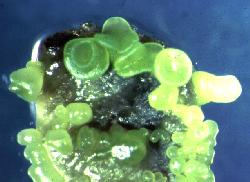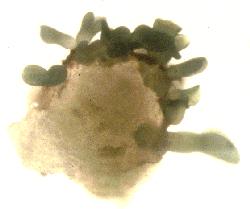Various growth regulators have been used to induce somatic embryos from soybean. The two which have been the most widely used are 2,4-D and NAA. Somatic embryos are able to reach the cotyledonary stage in the presence of exogenous NAA, and never go repetitive. In contrast, small amounts of exogenous 2,4-D are able to arrest the histodifferentiation of somatic embryos. If the level of exogenous 2,4-D is high enough, the somatic embryos will go repetitive. On the left are somatic embryos induced on 5 mg/L of 2,4-D. On the right are somatic embryos induced on 10 mg/L of NAA. Both are 30-days-old.


For more information on auxin effects, see:
R. C. Shoemaker, L. A. Amberger, R. G. Palmer, L. Oglesby, and J. P. Ranch. 1991. Effect of 2,4-dichlorophenoxyacetic acid concentration on somatic embryogenesis and heritable variation in soybean [Glycine max (L) Merr.]. In Vitro Cell.Dev.Biol. 27P:84-88.
